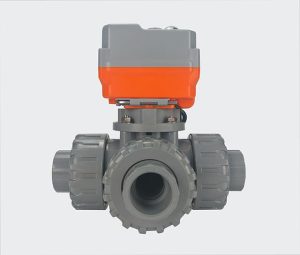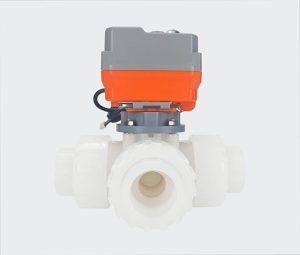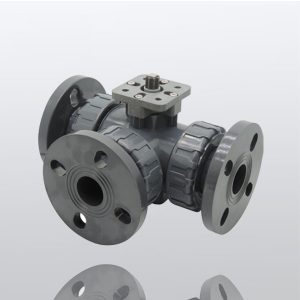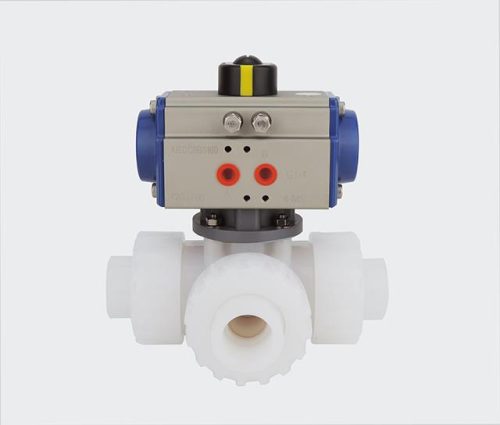PVDF ball valves have set a new standard for handling corrosive chemical environments, offering unmatched durability and performance. Unlike conventional plastic valves like PVC ball valves, CPVC ball valves, or other plastic ball valve options. PVDF valves excel in resisting harsh chemicals, extreme temperatures, and mechanical stress. Their unique material properties translate into longer service life, reduced maintenance, and significant cost savings over time. From chemical processing to wastewater treatment, industries relying on these valves benefit from reliable operation and compliance with strict standards. Discover why PVDF is the premium choice for challenging applications and how it significantly outperforms traditional plastic valve alternatives.

Introduction
Ball valves are pivotal components in industrial fluid control systems, prized for their efficient and reliable operation. These quarter-turn valves use a hollow, perforated, and pivoting ball to regulate the flow of liquids or gases. Offering precise control and an effective shut-off mechanism. Their simple yet robust design makes them a preferred choice for minimizing leaks. Ensuring operational safety, and optimizing process efficiency. In chemical processing, ball valves play a critical role in managing the flow of corrosive substances. Where maintaining the integrity of the system is paramount. With materials like PVC, CPVC, and PVDF available, their durability and resistance to aggressive chemicals vary. Making material selection essential to performance.
Among these, high-performance plastic valves such as PVDF ball valves stand out for their superior resistance to extreme chemical exposures and temperature variations. This reliability ensures seamless operation in demanding environments, safeguarding both the equipment and the process. Ball valves are indispensable in chemical handling systems, proving vital not only for operational control but also for maintaining the safety and economic viability of processing facilities.
Polyvinylidene Fluoride (PVDF) has emerged as one of the most advanced materials for manufacturing ball valves designed to excel in harsh environments. Renowned for its extraordinary chemical resistance, PVDF can withstand prolonged exposure to aggressive acids, bases, and solvents without degrading, making it an ideal choice for handling corrosive substances. Beyond its chemical resilience, PVDF boasts remarkable thermal stability, maintaining consistent performance across a wide range of temperatures. Which is critical in demanding industrial processes. Its mechanical strength ensures that ball valves constructed with PVDF can endure high pressures and mechanical stresses while maintaining reliable fluid control.
Additionally, PVDF is inherently non-toxic and resistant to UV radiation, further extending its applicability in areas. Such as chemical processing, wastewater treatment, and pharmaceuticals. These exceptional properties make PVDF ball valves a high-performance solution that delivers durability, safety, and efficiency in the most challenging operational conditions. Surpassing the capabilities of more traditional materials like PVC and CPVC.
Section 1: Material Properties of PVDF and its Advantages
PVDF, or polyvinylidene fluoride, stands out as a high-performance thermoplastic polymer, prized for its unique combination of chemical resistance, thermal stability, and mechanical strength. Its unparalleled resistance to a wide range of aggressive chemicals. Including acids, bases, and organic solvents, ensures its durability in environments that would quickly degrade many other materials. This chemical resilience is vital for applications in industries such as chemical processing. Where exposure to corrosive substances is constant.
PVDF also offers exceptional thermal stability, capable of maintaining structural integrity and reliable performance in temperatures as high as 150°C without significant warping or loss of strength. This makes it especially valuable in processes where temperature fluctuations and high heat are common.
Additionally, PVDF’s robust mechanical strength allows it to withstand high pressures and environmental stress. While its inherent resistance to UV radiation and abrasion further enhances its longevity in outdoor or heavily operational settings. These characteristics not only guarantee reliable performance but also reduce maintenance and operational disruptions, solidifying PVDF as an ideal choice for demanding industrial applications, from pharmaceutical production to wastewater treatment systems.
PVDF (polyvinylidene fluoride) excels in corrosive chemical handling due to its unparalleled material properties. Which make it a top choice for challenging industrial applications. Its high chemical resistance allows it to withstand prolonged exposure to aggressive agents such as concentrated acids, alkalis, and organic solvents. Ensuring it maintains integrity and performance where other materials would degrade or fail. This resistance is critical in environments like chemical processing plants, where equipment is consistently exposed to harsh substances. Thermal stability is another key advantage; PVDF remains effective in environments with temperature fluctuations or sustained high heat. Performing reliably at temperatures up to 150°C.
This attribute is particularly valuable in scenarios such as high-temperature chemical reactions or heated fluid transfer systems. Where material failure could have costly consequences. Additionally, its robust mechanical strength enables PVDF to endure high pressures and resist mechanical stress without compromising structural integrity. Making it well-suited for applications like pipelines and storage tanks that require durability under demanding conditions. Its resistance to UV radiation and abrasion further ensures long-term reliability. Even in outdoor or intensely operational environments. By combining these properties, PVDF provides a long-lasting, low-maintenance solution for handling corrosive chemicals safely and efficiently. Reducing downtime and operational risks across a spectrum of industrial sectors.
Section 2: How PVDF Ball Valves Enhance Process Performance
PVDF ball valves provide quantifiable improvements across several critical parameters, making them a superior choice for industrial applications. When it comes to lifespan, PVDF outperforms other materials like PVC and CPVC by offering exceptional resistance to wear and degradation, even under constant exposure to highly corrosive chemicals and extreme temperatures. This durability often results in a service life that can be up to three times longer than traditional plastic valves. Chemical compatibility is another standout feature, as PVDF can handle a broader spectrum of aggressive substances, including concentrated acids, strong bases, and complex organic solvents, without compromising structural integrity. This leads to greater reliability and reduced risks of system failure.
Operational efficiency also sees significant gains with PVDF ball valves due to their low maintenance requirements and ability to maintain seamless performance in demanding conditions. Their high thermal and mechanical stability minimizes disruptions caused by temperature fluctuations or pressure changes, ensuring consistent process control. These quantifiable advantages make PVDF ball valves a cost-effective and performance-driven solution for industries that demand precision, reliability, and safety in the most challenging environments.
Section 3: Cost Efficiency and Long-Term Benefits
PVDF ball valves significantly reduce maintenance requirements and downtime in chemical environments by offering exceptional durability and resistance to wear and corrosion. Engineered to withstand prolonged exposure to highly aggressive chemicals, these valves maintain their structural integrity where other materials. Such as traditional plastics or metals, often fail. The superior chemical compatibility of PVDF ensures that these ball valves resist degradation from acids, bases, solvents, and other corrosive substances commonly encountered in industrial processes.
Additionally, their excellent thermal stability allows them to perform consistently across a wide range of temperatures. Minimizing performance issues caused by thermal expansion or contraction. This inherent robustness reduces the frequency of necessary inspections, repairs, and part replacements, translating to fewer interruptions in operational workflows.
Furthermore, the smooth interior surfaces of PVDF ball valves help prevent material buildup, clogging, or contamination, which are common issues that demand regular maintenance. By ensuring long-lasting performance while reducing the likelihood of unexpected failures, PVDF ball valves not only improve operational efficiency but also deliver significant cost savings over time. Making them an ideal solution for demanding chemical environments.

Section 4: Applications of PVDF Ball Valves in Corrosive Chemical Industries
PVDF ball valves serve as a critical component across a variety of industries due to their unmatched chemical resistance, durability, and reliability in extreme conditions. The chemical processing industry greatly benefits from these valves. As they are adept at handling highly corrosive substances such as concentrated acids, strong alkalis, and volatile solvents without degrading or compromising operational safety. This capability ensures consistent performance in intricate and sensitive chemical reactions.
In wastewater treatment, PVDF ball valves excel by resisting the aggressive chemical agents used for water disinfection, pH control, and pollutant removal. Their high durability reduces maintenance demands, making them well-suited to the continuous operation required in these systems. The pharmaceutical industry also relies on PVDF ball valves thanks to their non-reactive, non-toxic properties and resistance to contamination. Which are essential for maintaining stringent purity regulations during drug production and handling.
Across these industries, the ability of PVDF ball valves to withstand harsh environments, minimize downtime, and deliver long-term efficiency makes them a preferred choice for critical applications where reliability and safety cannot be compromised.
Showcase
PVDF ball valves consistently outperform alternatives like PVC and CPVC in critical applications that require superior chemical resistance, thermal stability, and long-term reliability. For instance, in chemical processing plants handling highly corrosive substances such as concentrated sulfuric acid or hydrofluoric acid, PVC and CPVC valves often fail prematurely due to material degradation, leading to leaks, downtime, and high maintenance costs. Conversely, PVDF valves maintain their integrity and performance, ensuring safe and uninterrupted operations. Similarly, in wastewater treatment facilities where exposure to aggressive chemicals like sodium hypochlorite and acidic waste streams is routine, PVDF outshines its counterparts by resisting chemical attack and UV-related degradation. Making it a reliable choice for outdoor installations.
Another compelling example is in the pharmaceutical industry, where production processes require maintaining purity under high temperatures and cleanliness demands. Unlike CPVC, which may soften or contaminate under extreme conditions, PVDF’s thermal stability and low permeability ensure consistent performance without compromising product quality. These scenarios highlight PVDF ball valves as a cost-effective investment, reducing the frequency of replacements, lowering maintenance costs. And ensuring minimal process interruptions in the most demanding industrial environments.
Section 5: Comparison with PVC and CPVC Ball Valves
When comparing PVDF, PVC, and CPVC ball valves, the distinctions in their features underscore their suitability for specific industrial applications. PVDF stands out with its unparalleled chemical resistance, capable of withstanding highly aggressive chemicals. Including concentrated acids, bases, and organic solvents, without degradation. This makes it ideal for use in harsh chemical environments. Its thermal tolerance surpasses that of PVC and CPVC. As PVDF can handle a broader temperature range, typically performing reliably in conditions up to 150°C, compared to PVC’s upper limit of approximately 60°C and CPVC’s 93°C.
Additionally, PVDF offers superior durability, resisting abrasion, UV light, and radiation, making it a robust choice for long-term applications in demanding environments. PVC, on the other hand, is more economical and lightweight but has limited chemical and thermal resistance. Making it better suited for applications involving less aggressive substances and moderate temperature conditions.
CPVC improves upon PVC with enhanced chemical compatibility and a higher temperature rating. Making it a reasonable middle-ground option for industries needing moderate resistance to corrosive agents and improved thermal performance.
However, CPVC’s lack of resilience under extreme conditions leaves a gap that PVDF readily fills. For industries requiring top-tier durability, wide-ranging chemical compatibility, and high-temperature performance. PVDF ball valves represent a superior solution, while PVC and CPVC are more cost-effective alternatives for less demanding environments.
FAQ
1. What sizes are available for PVDF ball valves?
PVDF ball valves are available in a range of sizes, typically starting from 1/2 inch (DN15) up to 4 inches (DN100). Custom sizing may be available depending on the manufacturer.
2. Where are PVDF ball valves typically used?
These valves are commonly utilised in industries such as:
Chemical Processing
Water Treatment Plants
Pharmaceutical Manufacturing
Oil & Gas Applications
Semiconductor Fabrication
3. How do you maintain a PVDF ball valve?
Maintenance is minimal with PVDF ball valves as their non-reactive surface prevents scaling and corrosion. However, regular inspections for wear, leakage, and proper operation are recommended to ensure optimal performance over time.
4. Are PVDF ball valves suitable for high-pressure systems?
Yes, PVDF ball valves are designed to handle moderate to high-pressure systems, with pressure ratings typically varying between 10 and 16 bar depending on the valve’s design and size.
Conclusion
PVDF ball valves prove to be an outstanding solution for achieving reliable and long-lasting performance in the most challenging corrosive chemical environments. Their exceptional chemical resistance enables them to withstand exposure to highly aggressive substances that would degrade or corrode traditional materials, ensuring operational safety and product integrity. Coupled with impressive thermal stability, these valves maintain consistent functionality across a wide temperature spectrum. Making them an ideal choice for industries requiring precision and dependability under extreme conditions. Their durability further sets them apart. As they resist wear, UV light, and radiation, providing prolonged service life even in demanding applications.
These attributes not only reduce the frequency and cost of maintenance but also minimize unexpected downtime, fostering smoother workflows and greater operational efficiency. When considering lifecycle costs, PVDF ball valves deliver significant value by optimizing performance while lowering long-term expenses. For industries like chemical processing, wastewater treatment, and pharmaceuticals, where reliability and safety are paramount. PVDF ball valves represent an advanced, cost-effective investment for sustainable and efficient operations.


